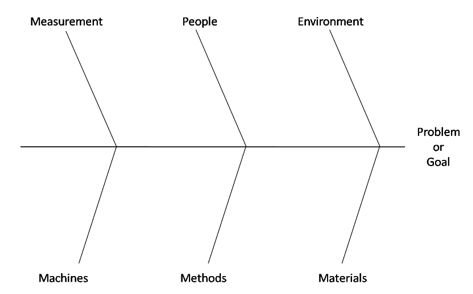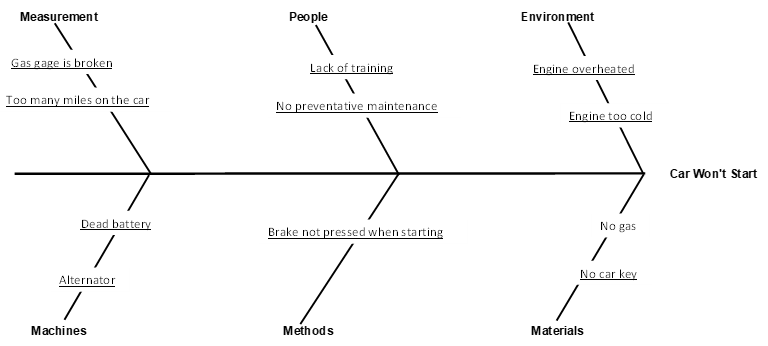A cause and effect diagram is a tool that shows the relationship between a quality characteristic (effect) and possible sources of variation (causes). As shown below, the effect could be a problem that needs to be solved or the goal of the process. The effect would then be listed on the cause and effect diagram. The causes involve everything that might trigger the problem. Cause and effect diagrams are also called fishbone diagrams (because of their shape) and Ishikawa diagrams (because of their developer).
The cause and effect diagram is one of many root cause analysis tools. Root cause analysis should be thorough enough to “root” out the deep and hidden causes that are often missed with quick fixes to problems. So, the more elaborate the diagram, the better the chance of rooting out the problem in the process.
The figure below is an example of a cause and effect diagram for a car that won’t start. The “causes” of variation in this characteristic are categorized into six main factors: measurement, people, environment, machines, methods and materials. These six factors are often referred to as the “4Ms, a P and an E.” Each of these main factors is divided into detailed causes. For example, a detailed cause under the “Machines” main is a dead battery.
The six main factors in the diagram are often used for cause and effect diagrams. However, you may pick any factors you want to be the main factors. The steps in constructing a cause and effect diagram are given below.
- Pinpoint the problem you want to solve or the goal you want to reach.
- Write the problem or the goal (effect) on the right-hand side and draw a horizontal line to the left.
- Select the categories for the causes of the problem or what has to be done to achieve the goal. Most often, these categories will be the 4Ms, a P and an E. These categories will be the main factors of the cause and effect diagram. Each main factor forms a branch off the horizontal line as shown above.
- Brainstorm detailed causes for each main factor. These detailed causes are written on branches off those of the main factors.
- Always try to branch further by continuously asking, “What causes variation in this branch?” In this way, you can add to the cause and effect diagram until it fully shows all the possible causes of variation.
The most difficult thing to do with a cause and effect diagram is to analyze it after it is completed. How can you determine what the true cause is? Our next blog will examine this.
Our SPC for Excel software allows you to create cause and effect diagrams in Excel.

